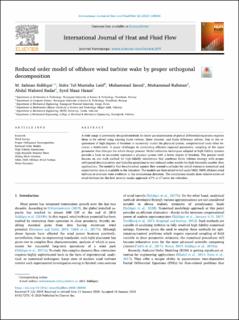| dc.contributor.author | Siddiqui, Muhammad Salman | |
| dc.contributor.author | Latif, Sidra Tul Muntaha | |
| dc.contributor.author | Saeed, Muhammad | |
| dc.contributor.author | Rahman, Muhammad | |
| dc.contributor.author | Badar, Abdul Waheed | |
| dc.contributor.author | Hasan, Syed Maaz | |
| dc.date.accessioned | 2020-06-25T07:43:41Z | |
| dc.date.available | 2020-06-25T07:43:41Z | |
| dc.date.created | 2020-06-22T22:33:56Z | |
| dc.date.issued | 2020 | |
| dc.identifier.citation | International Journal of Heat and Fluid Flow. 2020, 82 108554. | en_US |
| dc.identifier.issn | 0142-727X | |
| dc.identifier.uri | https://hdl.handle.net/11250/2659408 | |
| dc.description.abstract | A wide range of previously designed methods for faster parametrization of partial differential equations requires them to be solved using existing finite volume, finite element, and finite difference solvers. Due to the requirement of high degrees of freedom to accurately model the physical system, computational costs often becomes a bottle-neck. It poses challenges to conducting efficient repeated parametric sampling of the input parameter that disrupts the whole design process. Model reduction techniques adopted to high fidelity systems provide a basis to accurately represent a physical system with a lower degree of freedom. The present work focuses on one such method for high-fidelity simulations that combines finite volume strategy with proper orthogonal decomposition and Galerkin projection to test reduced-order models for high Reynolds number flow applications. The model is first benchmarked against flow around a cylinder for which extensive numerical and experimental data is available in the literature. The models are then tested to full-scale NREL 5MW offshore wind turbines to evaluate wake evolution in the downstream direction. The simulations results show relative errors of wind turbines for the first seventy modes approach 4.7% in L2-norm for velocities. | en_US |
| dc.language.iso | eng | en_US |
| dc.publisher | Elsevier | en_US |
| dc.rights | Navngivelse 4.0 Internasjonal | * |
| dc.rights.uri | http://creativecommons.org/licenses/by/4.0/deed.no | * |
| dc.title | Reduced order model of offshore wind turbine wake by proper orthogonal decomposition | en_US |
| dc.type | Peer reviewed | en_US |
| dc.type | Journal article | en_US |
| dc.description.version | publishedVersion | en_US |
| dc.source.volume | 82 | en_US |
| dc.source.journal | International Journal of Heat and Fluid Flow | en_US |
| dc.identifier.doi | https://doi.org/10.1016/j.ijheatfluidflow.2020.108554 | |
| dc.identifier.cristin | 1816665 | |
| dc.description.localcode | This is an open access article distributed under the terms of the Creative Commons CC-BY license, which permits unrestricted use, distribution, and reproduction in any medium, provided the original work is properly cited. | en_US |
| cristin.ispublished | true | |
| cristin.fulltext | original | |
| cristin.qualitycode | 1 | |

